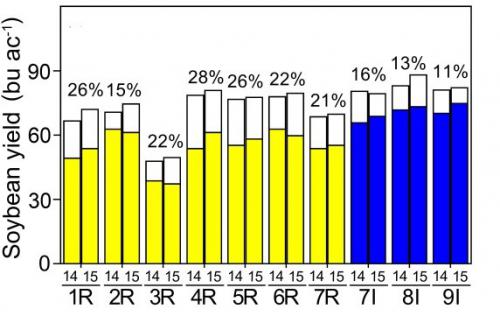Summary of the Michigan soybean benchmarking and yield gap surveys (2014 and 2015)
Summary of the soybean yield gaps in Michigan and some management practices that are likely to be responsible for them.

Michigan is participating in a multi-state, checkoff-funded project to identify soybean yield gaps and the management practices responsible for them. To accomplish this, we asked soybean producers to provide field-specific information regarding management practices, crop inputs and yields from four fields in 2014, 2015 and 2016. Information was collected from 149 fields in 2014, 168 fields in 2015 and 340 fields in 2016. Only the 2014 and 2015 surveys for rain-fed fields in Michigan have been summarized and included in this article.
Producers were also asked to provide the location for each field. The field location information was used solely to identify regions having similar soil and climatic conditions and group the surveyed fields within the identified regions. The four factors used to identify the regions have a significant effect on soybean yield potential and are listed below:
- Annual growing degree-day accumulation.
- Annual precipitation.
- Annual temperature fluctuations.
- Plant available water-holding capacity in the rooting zone.
The surveyed fields from Michigan were grouped into two regions (1R, green, and 4R, yellow) based on these factors as shown in Figure 1. The R and I following the number indicate rain-fed and irrigated regions.
Soybean yield gap is defined as the difference between the yield potential for a given region and the yield reported by producers from that region. The yield potential for each region was estimated using actual daily weather data collected from two to three weather stations located near the highest concentration of surveyed fields. The average yield gap for both years in each region is presented at the top of the bars in Figure 2. The top of the colored portion of each bar in the figure represents the actual reported yields and the top of each bar is the yield potential.
The bad news is that the yield gaps for the two regions in Michigan rank the highest of all 10 regions. The good news is we have more opportunity to produce higher yields through management.

Figure 2. Comparison between the actual reported yields and crop model estimates for yield potential in 10 regions within the north central United States. Yellow/light = rain-fed and blue/dark = irrigated.
In order to identify the management practices responsible for the yield gap within a region, the fields were ranked by yield and then divided into a high-yield group and a low-yield group. The high-yield group represented the top third of the fields and the low-yield group represented the bottom third of the fields in a given region.
The management practices implemented by the two groups were compared and statistically analyzed. Five practices (planting date, tillage, foliar fungicide and insecticide, drainage system and soybean maturity group) were identified as having a 90 percent probability of explaining the yield gap in half or more of the 10 regions.
In region 4R, the high-yield group had 25 percent more tilled fields, was planted eight days earlier, planted 20 percent more fields in wide rows, planted varieties that were 0.1 of a maturity group later and applied a foliar fungicide or insecticide in 31 percent more fields than the low-yield group (Table 1). In region 1R, the high-yield group planted 10 days earlier and planted varieties that were 0.2 of a maturity group earlier than the low-yield group.
| Table 1. Comparison of producer yield, selected management practices and applied inputs between the top third (high-yield) and bottom third (low-yield) yielding fields in two regions in Michigan. The values listed in the last two columns reflect the difference between the high-yield and low-yield groups for each of the management practices. | |||
|---|---|---|---|
| Management practice | Units | Region | |
| 1R (high-yield – low-yield) | 4R (high-yield – low-yield) | ||
| Tillage | % tilled fields | -3 | 25*** |
| Planting date | Days | -10*** | -8*** |
| Row spacing | % planted in wide rows | 11 | 20* |
| Maturity group | Unit less | -0.2* | 0.1* |
| Foliar fungicide and insecticide | % treated fields | 10 | 31*** |
Asterisks indicate statistical significance at p < 0.1(*), p < 0.05 (**) and p < 0.01 (***).
Planting date was the main management practice identified for explaining the yield gap in both regions in Michigan. For region 1R, yields decreased by 0.5 of a bushel per acre for each day that planting was delayed after May 1. In region 4R, yield losses of 0.4 of a bushel per acre per day were found. These values are consistent with the results obtained from replicated planting date trials conducted in Wisconsin and Michigan.
This summary of the 2014 and 2015 soybean benchmarking and yield gap producer surveys indicates the soybean yield gap for Michigan producers is between 26 and 28 percent. This is among the highest for the 10 identified regions in the north central U.S. The summary also identifies key management practices responsible for the yield gap, which can be implemented to increase soybean yields in the future. We will ask producers to complete and submit surveys again for 2017.
The information presented in this article, summarized by Mike Staton, was extracted from two, more comprehensive and detailed publications listed below:
- Assessing causes of yield gaps in agricultural areas with diversity in climate, published in Agricultural and Forest Meteorology
- Key management practices that explain soybean yield gaps across the north central US








 Print
Print Email
Email

